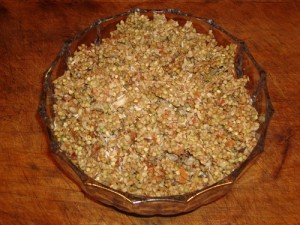 When fall turns to winter, we all start looking for our sugar fixes. We seem to have a physiologic insistence for heavier, denser food, specifically in the form of carbohydrates. For Craig and I, that urge hit on December 1st. For the most part, we eat the Paleolithic diet, which consists of raw foods, cooked vegetables and grilled meat. I occasionally eat quinoa but generally no grains, starches, dairy or refined sugars. The benefit of this kind of diet is my lymphoma stays in remission. I also have no ups and downs in terms of weight gain or energy level, and have zero food cravings. Reason enough to keep me on the straight and narrow, and feel good about it.
When fall turns to winter, we all start looking for our sugar fixes. We seem to have a physiologic insistence for heavier, denser food, specifically in the form of carbohydrates. For Craig and I, that urge hit on December 1st. For the most part, we eat the Paleolithic diet, which consists of raw foods, cooked vegetables and grilled meat. I occasionally eat quinoa but generally no grains, starches, dairy or refined sugars. The benefit of this kind of diet is my lymphoma stays in remission. I also have no ups and downs in terms of weight gain or energy level, and have zero food cravings. Reason enough to keep me on the straight and narrow, and feel good about it.
Craig has adapted well to this way of eating although he seems to have more carbohydrate requirements than I do. He occasionally eats some flat breads and rice, but it is fairly minimal. But when I saw him return from a food-shopping trip with packaged pancake mix, I knew it was time to build more carbohydrates into our winter diet. Lately, I also noticed myself prowling the kitchen on the hunt for a snack at night. My usual snack of celery and peanut butter wasn’t cutting it.
Although there are fantastic raw food desserts recipes to choose from for a high protein/low glycemic sugar fix, I tend to make raw sprouted granola as my snack of choice because it has just the right heft and crunch factor for my tastes. After pouring myself a heap of granola into a bowl, I add coconut or almond milk and call it good. Craig, well, he might not be as easily satisfied with raw sprouted granola as I am. I can hear him now crying out in his best grumpy old man imitation, “Where’s my pie?”
Why bother with soaking and sprouting grains? Because when grain is soaked in water, it ferments which helps to pre-digest it. And when the grain is sprouted, its nutrient (Vit B, C and protein) content is increased and its enzymes are intact.
Raw Sprouted Granola
2 cups sprouted buckwheat (soak buckwheat overnight, drain and let sit in a colander until a sprout forms to the length of the grain.
1 cup almonds (soak overnight) chop into chunks
1 cup sunflower seeds (soak overnight) chop into chunks
8 – 10 dates (soaked and pureed)
½ cup coconut flakes (optional)
1/3 cup coconut oil
¼ cup maple syrup (optional)
1 tsp cinnamon
½ tsp salt
Optional: You can add walnut, cashews, and pumpkin seeds.
Mix all the ingredients together. Dehydrate at 105 degrees until crunchy (12hrs). Add dried apricot or other dried fruits if you wish. Store in a glass Mason jar.

December 7, 2012
Rice Currency
Joyce Community Cure, Good Living Cure, Medicinal Food Cure
A few years ago we came under the tutelage of sake master, Ten Ridlon. Ten passed on all the technicalities and timing of adding the primary ingredients (water, rice, koji and yeast) over a forty-five day period. When rice and koji are introduced gradually into the fermentation, at repeated intervals, the yeasts produce alcohol at higher concentrations than any other type of fermented alcohol. It took awhile for us to acquire our own mastery over these few ingredients, but now we are making consistent delicious batches of Shiboritate Namazake Genshu Nigori Sake.
Let me explain these Japaenese terms:
Shiboritate means that it was just pressed. The sake we are selling on Saturday was pressed on Thursday night.
Namazake is a sake that has not been pasteurized. It has a live culture of probiotics, which requires refrigerated storage and has a shorter shelf-life than pasteurized sake.
Genshu is undiluted sake. Most sake is diluted with water after brewing to lower the alcohol content, but genshu is not.
Nigori is cloudy sake. The sake is passed through a loose mesh to separate it from the mash. It isn’t filtered thereafter and there is much rich sediment in the bottle. Before serving, the bottle is shaken to mix the sediment and turn the sake white or cloudy.
Unlike beer, sake, fermented rice wine, tastes more nutritive, and its sparkly, clean disposition reminds you that it is very much alive. I only drink it in tiny sips due to its high alcoholic content however; Craig enjoys sake with most meals. As grill master, he especially enjoys using it as a main ingredient for his moistening marinades for fish, pork and chicken. I use sake kasu, or sake lees, the remaining solids that were pressed from the liquid sake, for pickling, and experimentally in cooking. I also use it as a face mask.
In 8th century Japan, rice grains were traditionally used as a commodity, a means of currency. At Parsley Farm, we would like to continue trading in grain and we encourage our neighbors to develop their own mediums for currency so we can have a very vibrant and alive marketplace in Upper Rainier Beach.
Share this: